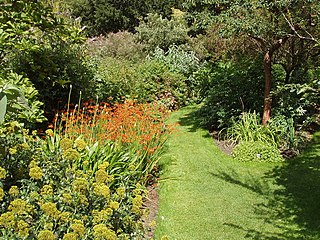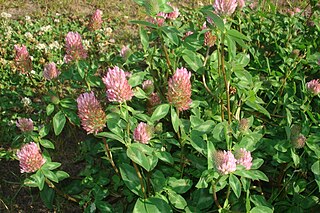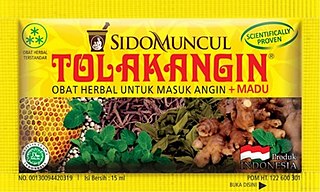 W
WHerbal medicine is the study of pharmacognosy and the use of medicinal plants, which are a basis of traditional medicine. There is limited scientific evidence for the safety and efficacy of plants used in 21st century herbalism, which generally does not provide standards for purity or dosage. The scope of herbal medicine commonly includes fungal and bee products, as well as minerals, shells and certain animal parts. Herbal medicine is also called phytomedicine or phytotherapy.
 W
WThis is an alphabetical list of plants used in herbalism.
 W
WAdaptogens or adaptogenic substances are used in herbal medicine for the claimed stabilization of physiological processes and promotion of homeostasis. The European Medicines Agency refutes the concept that adaptogens actually exist or work as claimed, and therefore the term "adaptogen" cannot be used for marketing in the EU.
 W
WAromatherapy is a pseudoscience based on the usage of aromatic materials, including essential oils, and other aroma compounds, with claims for improving psychological or physical well-being. It is offered as a complementary therapy or as a form of alternative medicine, the first meaning alongside standard treatments, the second instead of conventional, evidence-based treatments.
 W
WA botánica is a religious goods store. The name botánica is Spanish and translates as "botany" or "plant store," referring to these establishments' function as dispensaries of medicinal herbs. Botánicas are common in many Hispanic American countries and Latino communities around the world. Such establishments sell folk medicine, herbs, candles, and statues for Saints and popular gods. They also carry oils, incense, perfumes, and books. Such stores have become increasingly popular in the United States as the Latino communities they serve have grown in that country. A botánica is a site of healing and support, such that one owner says they are a "place of mysteries" due to the metaphysical appreciation of mystery as a synonym for spirit and divinity.
 W
WCannabis, also known as marijuana among other names, is a psychoactive drug from the Cannabis plant used primarily for medical and recreational purposes. Tetrahydrocannabinol (THC) is the main psychoactive component of cannabis, which is one of the 483 known compounds in the plant, including at least 65 other cannabinoids, including cannabidiol (CBD). Cannabis can be used by smoking, vaporizing, within food, or as an extract.
 W
WChyavanprash is a cooked mixture of sugar, honey, ghee, Indian gooseberry (amla) jam, sesame oil, berries and various herbs and spices. It is prepared as per the instructions suggested in Ayurvedic texts. Chyavanprash is widely sold and consumed in India as a dietary supplement.
 W
WCold-FX is a product derived from the roots of North American ginseng. It was formulated by Jacqueline Shan and originally manufactured by her company, Afexa Life Sciences, which was acquired by Valeant Pharmaceuticals in 2011.
 W
WDecoction is a method of extraction by boiling herbal or plant material to dissolve the chemicals of the material, which may include stems, roots, bark and rhizomes. Decoction involves first mashing the plant material to allow for maximum dissolution, and then boiling in water to extract oils, volatile organic compounds and other various chemical substances. Decoction can be used to make tisanes, tinctures and similar solutions. Decoctions and infusions may produce liquids with differing chemical properties as the temperature and/or preparation difference may result in more oil-soluble chemicals in decoctions versus infusions. The process can also be applied to meats and vegetables to prepare bouillon or stock, though the term is typically only used to describe boiled plant extracts, usually for medicinal or scientific purposes.
 W
WThe doctrine of signatures, dating from the time of Dioscorides and Galen, states that herbs resembling various parts of the body can be used by herbalists to treat ailments of those body parts. A theological justification, as stated by botanists such as William Coles, was that God would have wanted to show men what plants would be useful for.
 W
WThe use of cannabis as a recreational drug has been outlawed in many countries for several decades. As a result of long-fought legalization efforts, several countries such as Uruguay and Canada, as well as several states in the US, have legalized the production, sale, possession, and recreational and/or medical usage of cannabis. The broad legalization of cannabis in this fashion can have numerous effects on the economy and society in which it is legalised.
 W
WFemarelle is a dietary supplement that is a mixture of DT56a and flaxseed powder, that may act as a selective estrogen receptor modulator (SERM). In 2008 an application was submitted to the European Food Safety Authority to market Femarelle with a health claim, namely that it can reduce the risk for osteoporosis and other bone disorders; the EFSA found that "the food/constituent for which the claim is made, i.e. Femarelle, has not been sufficiently characterised" and that " a cause and effect relationship has not been established between the consumption of Femarelle and increased BMD, increased bone formation, or decreased risk of osteoporosis or other bone disorders in post-menopausal women."
 W
WFlora Huayaquilensis is the popular name for the body of work produced by botanist Juan José Tafalla Navascués while he was in South America.
 W
WGreen coffee extract is an extract of unroasted, green coffee beans. It is used in the Swiss Water Process for decaffeinating coffee. It has also been used as a weight-loss supplement and as an ingredient in other weight-loss products but its efficacy and mechanism of action have been controversial.
 W
WA herbal is a book containing the names and descriptions of plants, usually with information on their medicinal, tonic, culinary, toxic, hallucinatory, aromatic, or magical powers, and the legends associated with them. A herbal may also classify the plants it describes, may give recipes for herbal extracts, tinctures, or potions, and sometimes include mineral and animal medicaments in addition to those obtained from plants. Herbals were often illustrated to assist plant identification.
 W
WHerbal distillates, also known as floral waters, hydrosols, hydrolates, herbal waters, and essential waters, are aqueous products of hydrodistillation. They are colloidal suspensions of essential oils as well as water-soluble components obtained by steam distillation or hydrodistillation from plants/herbs. These herbal distillates have uses as flavorings and cosmetics. Popular herbal distillates for skincare include rose water, orange flower water, and witch hazel. Rosemary, oregano and thyme are very popular hydrosols for food production.
 W
WIn herbal medicine, a herbal tonic is used to help restore, tone and invigorate systems in the body or to promote general health and well-being. An herbal tonic is a solution or other preparation made from a specially selected assortment of plants known as herbs. They are steeped in water and drunk either hot or cool. Herbal tonics are believed to have healing properties ranging from relieving muscle and joint pain and extend as far as inhibiting some cancers.
 W
WHerbal viagra is a name that can be given to any herbal product advertised as treating erectile dysfunction. There are many different products advertised as herbal viagra, but with varying ingredients. There are no clinical trials or scientific studies that support the effectiveness of any of these ingredients for the treatment of erectile dysfunction and some products have been found to contain drugs and other adulterants, and have been the subject of FDA and FTC warnings and actions to remove them from the market.
 W
WThe history of medicine in the Philippines discusses the folk medicinal practices and the medical applications used in Philippine society from the prehistoric times before the Spaniards were able to set a firm foothold on the islands of the Philippines for over 300 years, to the transition from Spanish rule to fifty-year American colonial embrace of the Philippines, and up to the establishment of the Philippine Republic of the present. Although according to Dr. José Policarpio Bantug in his book A Short History of Medicine in the Philippines During The Spanish Regime, 1565-1898 there were "no authentic monuments have come down to us that indicate with some certainty early medical practices" regarding the "beginnings of medicine in the Philippines" a historian from the United States named Edward Gaylord Borne described that the Philippines became "ahead of all the other European colonies" in providing healthcare to ill and invalid people during the start of the 17th century, a time period when the Philippines was a colony of Spain. From the 17th and 18th centuries, there had been a "state-of-the-art medical and pharmaceutical science" developed by Spanish friars based on Filipino curanderos that was "unique to the [Philippine] islands."
 W
WMedical cannabis, or medical marijuana (MMJ), is cannabis and cannabinoids that are prescribed by physicians for their patients. The use of cannabis as medicine has not been rigorously tested due to production and governmental restrictions, resulting in limited clinical research to define the safety and efficacy of using cannabis to treat diseases. Preliminary evidence suggests that cannabis can reduce nausea and vomiting during chemotherapy, improve appetite in people with HIV/AIDS, and reduce chronic pain and muscle spasms.
 W
WOfficinal drugs, plants and herbs are those which are sold in a chemist or druggist shop. Officinal medical preparations of such drugs are made in accordance with the prescriptions authorized by a pharmacopoeia. Officinal is not related to the word official. The classical Latin officina meant a workshop, manufactory, laboratory, and in medieval Latin was applied to a general storeroom. It thus became applied to a shop where goods were sold rather than a place where things were made. Whereas official descends from officium, meaning office, as in duty or position.
 W
WPhytochemistry is the study of phytochemicals, which are chemicals derived from plants. Phytochemists strive to describe the structures of the large number of secondary metabolites found in plants, the functions of these compounds in human and plant biology, and the biosynthesis of these compounds. Plants synthesize phytochemicals for many reasons, including to protect themselves against insect attacks and plant diseases. The compounds found in plants are of many kinds, but most can be grouped into four major biosynthetic classes: alkaloids, phenylpropanoids, polyketides, and terpenoids.
 W
WRimostil is a dietary supplement and extract of isoflavones from red clover which was under development by Kazia Therapeutics for the prevention of postmenopausal osteoporosis and cardiovascular disease and for the treatment of menopausal symptoms and hyperlipidemia but was never approved for medical use. It is enriched with isoflavone phytoestrogens such as formononetin, biochanin A, daidzein, and genistein, and is proposed to act as a selective estrogen receptor modulator, with both estrogenic and antiestrogenic effects in different tissues. The extract reached phase II clinical trials for cardiovascular disorders, hyperlipidemia, and postmenopausal osteoporosis prior to the discontinuation of its development in 2007.
 W
WSwedish bitters, also called Swedish tincture, is a bitter and a traditional herbal tonic, the use of which dates back to the 15th century.
 W
WTolak Angin is a herbal supplement product produced in Indonesia by Sido Muncul. Sold as a syrup packaged in yellow sachets, it is one of the most popular brands in Indonesia.
 W
WYagen (薬研) is a crushing tool used in phytotherapy in Japan. It uses a wheel which is rolled back and forth to crush ingredients.